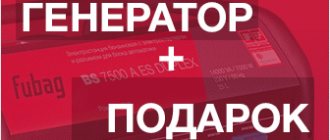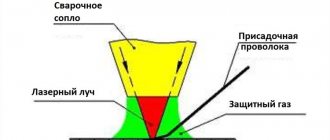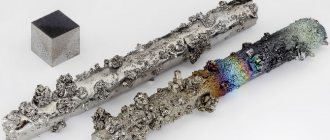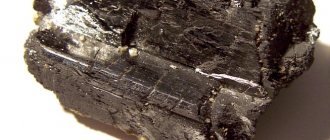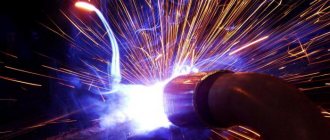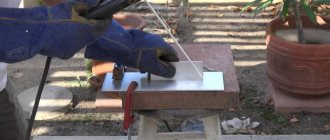One of the most common non-ferrous metals is aluminum; it is used both in pure form and as part of alloys. Various parts are made from duralumin, so welders often have to deal with this material. The complexity is due to the fact that in addition to aluminum, such an alloy also contains other metals, such as Cu, Mg, Mn. Welding duralumin is a complex technological process that requires some skills, so it will be difficult for a beginner to cope with it.
Welders often encounter aluminum.
What is duralumin
Duralumin consists of the following elements: aluminum - 93.5%, copper - 4.5%, magnesium - 1.5%, manganese - 0.5%. This composition determines the performance characteristics of the alloy. The main component affects the chemical activity of duralumin, so it quickly oxidizes in open air, resulting in the formation of a durable oxide film on the surface.
The given alloy composition is not constant, it can change. Not only the ratio of metals is important, but also the technology of heat treatment of duralumin.
Welding duralumin with argon
Aluminum is a metal that has high quality characteristics and is actively used in industry. The most common aluminum alloy is duralumin, which got its name thanks to the aluminum alloy, which was the first to produce such a compound.
Welding duralumin is a rather labor-intensive process that requires concentration and care. The complexity of welding work is due to the performance characteristics of aluminum, because in the duralumin alloy, the amount of aluminum is 93.5%.
The alloy also contains copper - 4.5%, magnesium - 1.5%, manganese - 0.5%.
This alloy is quite often used in industry, and therefore welders constantly have to work with this composition. Welding duralumin should be carried out by a person with experience, since the technology is not simple and one has to deal with a number of nuances during the welding process. Therefore, a beginner is unlikely to be able to weld duralumin on his own.
Note! Duralumin weighs little, but is a very strong and reliable alloy.
A guide to welding aluminum with argon for beginners
Do you want to conquer aluminum - this capricious, lightweight material with high electrical conductivity? Friends, it is possible!
Let's look at how to weld aluminum with argon for beginners; every beginner will learn step-by-step instructions with photos and videos.
How to set up the device
Let's look at the step-by-step instructions for beginners using the Ironman 200 AC/DC welding inverter as an example.
1) The leftmost function is the AC balance setting (CLEAN WD.), which has 2 polarities - minus and plus.
Our connection technology uses 50/50 polarity; the polarity changes depending on the type of task. For example, when welding pure aluminum, the balance is adjusted in the negative range. This way the metal, bath, and electrode will heat up less, and the seams will turn out thin and beautiful. Due to the low heating of the electrode, it can be sharpened more sharply.
For dirty aluminum, it is better to set the positive range, so the heating of the metal will be stronger, and the cleaning of the bath will be better.
Be careful: a positive half-wave has a detrimental effect on the tungsten electrode.
Based on the diameter of the electrode, the correct balance of alternating current is adjusted.
2) The next function (CURRENT) is the welding current setting. To weld aluminum, for example, 2 mm thick, it is enough to set the force to 60-65 A.
3) Third toggle switch (DOWN SLOPE) - crater filling setting (slow arc decay). Setting the arc decay time depends on the thickness of the metal. For 2 mm it is enough to set it to 3 seconds.
: for setting up a TIG machine.
Material preparation and process technology
The technique of welding aluminum differs from other types of metal joints. Aluminum is a thermally conductive material with a low melting point.
Please note: at the beginning of the work, the workpieces must be warmed up well (as if there is not enough current), and during the welding process the aluminum quickly overheats (excess current) - take these nuances into account.
How to clean workpieces? You can use a steel brush.
Or, degreasers:
- acetone;
- alcohol;
- special cleaners.
So, welding duralumin with argon for beginners in stages. Take a thicker piece of silver-white material, clean it thoroughly and learn how to weld a beautiful seam.
Low weldability of aluminum - what's the matter?
The low weldability of aluminum alloys is due to a number of their qualities.
- An oxide film that covers aluminum and its alloys. Its melting point is 2044C, and the melting point of the metal itself is 660C.
- The high fluidity of the molten metal makes it difficult to control the weld pool, for which it is necessary to install special heat-dissipating pads.
- When heated, hydrogen begins to escape from aluminum, which, after the metal hardens, leaves pores and cracks in its body.
- High shrinkage rate. And this leads to deformation of the welding seam during its cooling.
- The thermal conductivity of aluminum alloys is higher than that of steel, so a current is used to weld them, which is higher in strength than the current for welding steel structures. The difference is about twofold.
- If we talk about welding aluminum with our own hands in a home workshop, then most likely you will not come across pure aluminum. Most likely, it will be an alloy of an unknown brand (duralumin and others), for which, when welding, you will have to adjust the welding mode and select additional materials.
Aluminum welding methods
There are many methods for welding aluminum alloys, using different types of machines and welding materials. There are three main ones:
The last option can be called a technology for welding aluminum without argon.
Attention! In the process of welding aluminum or its alloys, it is important to destroy the oxide layer that is located on the surface of the metal. Therefore, in this process, either alternating or direct current of reverse polarity is used.
How to cook aluminum correctly
It all starts with preparing the parts, or more precisely, the edges to be joined. The main goal is to clean them of contaminants. Therefore, the edges of aluminum blanks are first cleaned with chemical compounds, and after drying, degreasing is carried out; for this, you can use any solvent: acetone, white spirit, aviation gasoline and other liquids.
If you plan to weld thick aluminum workpieces (more than 4 mm), then their edges must be cut. There are several cutting options, for example, creating tapered edges.
And the last operation in the preparation process is to clean the edges from the oxide film. To do this, you can use a file or coarse sandpaper.
As you can see, preparing aluminum for welding is a very simple process.
Technology of aluminum welding with coated piece electrodes
Welding aluminum with a (coated) electrode has its own designation code for the welding mode - MMA. It is used for joining metals with a thickness of at least 4 mm, and when assembling non-critical structures.
This technology is of low quality, because during the welding process of aluminum and its alloys, pores remain inside the weld, which reduces its strength.
During the process itself, metal splashes, and hardened slag balls are poorly separated, which increases corrosion.
Features of welding aluminum with coated electrodes:
- You can only cook with direct current with reverse polarity.
- The current strength is calculated from the ratio: for 1 mm of workpiece thickness, a current of 25-30 amperes is used.
- To form a high-quality seam, it is necessary to heat the edges of the two parts being welded to 300C, if the thickness of the workpieces is average. And up to 400C with thick workpieces.
- Heating and slow cooling is a mandatory rule that must be followed in order to obtain a high-quality seam.
- Aluminum welding must be performed continuously using a single electrode. The thing is that when the electric arc breaks, a slag film forms on the bath and on the electrode, which blocks the passage of electric current, that is, this is an obstacle to the re-ignition of the arc.
- After the process is completed, the seam must be cleaned of slag, which will cause the formation of corrosion zones.
- You can clean it with hot water followed by a wire brush.
Properties and weldability of duralumin
The difficulties of the welding process of duralumin are largely explained by its refractoriness. Compared to the main component, this composition is more dense, so it is less soft and flexible. During welding, electrodes are quickly consumed, and the fluidity of the alloy increases. You need to prepare for this before starting welding. Preliminary hardening of duralumin parts helps to eliminate this problem; it is performed at a temperature of +500°C.
Basic properties:
- density – 2.5-2.8 tons/m³;
- melting point – +650°C;
- Max fluidity – 250 MPa.
This material has high strength and relatively low weight, which makes it possible to make parts, mechanisms and structures from it that are used in various industries, the national economy and in everyday life.
Due to its high tendency to oxidize, duralumin is cooked at temperatures within +300°C, using a protective atmosphere of inert gases or flux.
This material is very refractory.
Advantages and disadvantages
Among the advantages of this alloy, the following are noted:
- light weight, but duralumin parts can withstand high loads;
- welding work is performed using different technologies, their choice depends on the work conditions and other factors;
- preparing products does not require much labor and time;
- the necessary electrodes can always be purchased in specialized stores.
We recommend reading: How to cook aluminum in an argon environment
This process also has a number of disadvantages:
- the weld seam has low resistance to corrosion;
- after creating such a connection, the characteristics of the alloy deteriorate;
- To carry out work, you must have high qualifications, be careful and perform everything with high precision;
- to select electrodes, you need to know exactly the grade of the alloy;
- the high fluidity of duralumin creates difficulties when forming a welding bead;
- to perform the work efficiently, you have to use flux or shielding gas;
- the cost of consumables is high;
- When performing high-speed welding, it is difficult to organize quality control of the seam.
The seam may be subject to corrosion.
Requirements for welding
When welding parts made of duralumin, you must adhere to the following requirements:
- Flux is preliminarily applied to the joint and evenly distributed, this allows to improve the welding process;
- heating of the parts to be joined is carried out evenly, otherwise they may become deformed under the influence of temperature;
- after completion of the work, the created seam is heated for some time, do this until the metal cools down;
- After welding and cooling of the seam, it is cleaned of slag and checked for cracks, cavities, and damage.
Preparation before the welding process
To obtain a high-quality connection, the surface of the parts must be properly prepared before starting work. This will help remove the oxide film, which has a high density and melting point, which does not allow the arc to form stably, resulting in reduced connection reliability.
The preparatory process consists of the following stages:
- Cleaning the surface from corrosion, oil and other contaminants.
- To remove the refractory layer, use a metal brush and fine-grained sandpaper to do this. In production, the oxide film is most often removed by cathode sputtering; in this case, it is treated with ions, which allows you to quickly and efficiently clean the surface.
- Degreasing the surface. In this case, not only the remaining oil is removed, but also the remaining particles that during the welding process interfere with the quality of the work.
- Edge processing. If the thickness of the welded sections is more than 4 mm, their corners are beveled at an angle of 35°.
Before using the electrodes, they are heated at a temperature of +150°C, which helps remove excess moisture. After the preparatory work, it is recommended to start welding; within 3 hours this can be done no later than 24 hours, because a strong oxide film is formed again.
Getting rid of corrosion.
Welding aluminum with electrodes
Almost every welder. Regardless of your experience, have you ever encountered aluminum welding? For this purpose, special electrodes are used, which are based on an aluminum rod .
Many people have difficulty welding aluminum correctly. To ensure that you do not have any difficulties, it is best to use Unitor ALUMIN-351N electrodes , which are designed specifically for welding aluminum. It can be used to weld aluminum sheets, pipes, covers, pistons and much more.
The main condition for welding aluminum products with these electrodes is a metal thickness of at least 2 millimeters. If you are going to weld aluminum with a thickness of more than 3 millimeters, then you must make a V-shaped groove at an angle of 60 degrees. In this case, the air gap should be no less than 1 and no more than 3 millimeters. If you are welding parts of small thickness with parts of greater thickness, then secure the thin metal appropriately. All the grooves that you have already prepared in advance. You need to thoroughly clean it of all kinds of contaminants.
When welding an aluminum product, use direct current with positive polarity. If you are going to weld cast or large parts, be sure to heat them to a temperature of about 300 degrees . Directly during the welding process itself, the electrode should be at a slight angle of inclination or vertical. The end of the electrode should move in the direction of the weld.
The most preferred position for welding with Unitor ALUMIN-351N electrodes is the lower position. The welding arc should be short and welding as fast as possible. When you have broken the welding arc, clean the metal surface from the slag crust and continue welding. The next welding bead should overlap the previous one by about 1 centimeter. The final seam must be cleaned and washed with water. Aluminum electrodes Unitor ALUMIN-351N should be stored in a dry place because they easily absorb moisture.
As you can see, welding aluminum is not very difficult. Unlike welded cast iron, aluminum is a soft metal that does not burst when the temperature drops sharply, but at the same time it is very light both in work and in weight. The simplicity of welding aluminum shows that in order to produce it correctly, you need to use only Unitor ALUMIN-351N electrodes, which allow you to weld the product you need not only quickly, but also with high quality.
Also, welding aluminum does not require any special welding skills, because compared to welding cast iron, welding aluminum is very simple. The main thing is to follow the recommendations of professional welders. In addition to the recommendations that you need to apply, be careful when handling metal.
For example, aluminum can quickly melt and ruin the material, and, for example, cast iron can be overheated or cooled too quickly. In both the first and second cases, you can damage your product. So, in order for the welding process to happen quickly, and most importantly with high quality, be careful and listen to the advice of professionals.
Required welding equipment
To carry out welding work with duralumin parts, a standard electric arc welding machine and consumable electrodes are used, and this is also done using a gas torch. In production for such purposes they use:
- semi-automatic machines in which the wire is fed in a protective gas environment, they are designated DC MIG;
- welding equipment that works with non-consumable electrodes placed in an argon environment, they are designated AC TIG.
We recommend reading: How to cook aluminum with a semi-automatic machine
For welding duralumin, equipment that supports operation with direct and alternating current is used. It must be inverter, compact, so that it can be transported. It is good when the machine is equipped with an oscillator for welding, and the length of the hose for connecting the torch is up to 3 m.
Where to begin?
Welding work begins with the preparation of workpieces. Various contaminants are thoroughly cleaned from the metal surface and degreased. You can work with sandpaper of various grains or a wire brush. Fats are effectively removed using acetone or solvent. After cleaning and degreasing, you should work on the edges, where the seam will be located in the future. If it turns out that your workpieces have edges of more than 4 mm, then they need to be beveled a little. An angle of no more than 35 degrees is considered optimal.
Duralumin welding technology
Although different equipment is used at home and in production for welding duralumin parts, the technology for carrying out the work is the same. The high fluidity of this material must be taken into account, so most often the work is performed in the lower position.
To avoid the formation of a large melt pool, the seam is made at high speed, and this will require high qualifications. At home, when using electric arc welding, you will not be able to obtain a high-quality connection. It will be porous, there will be residual stresses and cracks will appear.
Argon-arc
This technology involves the use of a non-consumable tungsten electrode that operates in a protective gas environment. Welding is performed using alternating current; modern machines have all the necessary settings, which helps simplify the process. Using this method helps to obtain a durable and high-quality seam, while the likelihood of corrosion will be minimal.
Semi-automatic
The use of a semi-automatic machine when welding duralumin is similar to how steel elements are connected using this method. The difference is that it is necessary to more carefully control the power of the arc and the advance of the wire, as well as increase its feed.
How to weld aluminum with an electrode
Many structures used in automobiles are made from aluminum. These can be engine blocks, gearboxes and body parts. Various containers are made from this stainless material for industrial and domestic needs. If a crack or fistula forms, it is better to weld the problem area in an argon environment using a special apparatus. But if this is not possible, then you can use an inverter. Welding aluminum with an electrode at home requires a certain mode and preliminary preparation. Specialized consumables are also used. How to do all this is described below and demonstrated in an additional video.
Welding process - difficulties in working with the material
An electric arc can be used to connect many types of iron. It has a fairly high combustion temperature, which makes it possible to melt plates of different thicknesses well and create reliable and airtight connections. But welding aluminum with an inverter is more difficult due to several specific features of this material.
The first difficulty is the hygroscopic properties of aluminum. The material is able to absorb surrounding moisture and accumulate in itself. This does not appear visibly on a cooled product, but will immediately become noticeable during welding. When the arc is ignited and the metal finds itself in a zone of elevated temperature, moisture begins to evaporate from its surface, inevitably entering the welding zone. This results in excessive spatter and interference with the seam. To prevent this phenomenon, preheating of the product with a burner at a temperature of 150-190 degrees is required. During the procedure, you can see the release of moisture on the surface.
Another difficulty is the oxide film that covers the entire product with a thin layer. It protects the metal from destruction in an acidic environment, but significantly interferes with welding with an inverter at home. The difficulty lies in the huge difference in melting temperatures. Aluminum material melts at 500 degrees, and its oxide at 2000 degrees. To eliminate this difference, it is necessary to clean the welding site with an iron brush, which gives access to the base metal.
Interaction with the surrounding air contributes to the formation of pores in the structure of the seam, which significantly reduces its sealing properties. Protection of the weld pool is carried out by supplying argon in the case of TIG, or by creating a gas cloud from the coated electrode when welding with an inverter at home.
Since pure aluminum is not used in products, other elements included in the alloy may be difficult to weld. Thus, grades Al2 and Al9 with a silumin content of 4 to 13% are considered to be weldable to a limited extent. The AMr1 and AMr6 brands have the same indicators, where manganese can be added from 2 to 6%. Duralumin D16 is difficult to weld.
We carry out welding: stages of work
How to weld aluminum became clear after numerous attempts and experiments. Below are step-by-step steps to get a quality connection at home:
- If the plates to be welded have a thickness of more than 5 mm, then cutting of the edges is necessary. The standard is to cut the edges at 45 degrees, but other values are allowed. It is worth noting that the larger the cutting angle, the wider the weld seam will be. When the plate thickness is more than 7 mm, a technological gap of 2 mm is required between them. If the working object is a crack, then it must be widened with a cutting disc and a grinder, otherwise the seam will be superficial.
- The prepared product must be heated. Moisture is removed using a propane-oxygen flame. This can be a cutter or a regular can with a household torch. The surface must be heated to 150 degrees. This can be checked with a special apparatus or visually by the dry state of the material.
- After heating, the oxide film is quickly removed. A regular metal brush will do for this. It is important to remove the refractory layer at the beginning of the welding zone. The subsequent action will be exerted by the electrode, whose composition and temperature corrode the oxide, allowing welding to be performed.
- Tacks are placed on the prepared material to secure the sides to be welded. The root seam must be drawn evenly, filling the gap. The angle relative to the parts being welded is required to be 90 degrees. This is unusual for novice welders, or those who have only worked with carbon steel. But this way the molten metal will more accurately reach the joint. After the surface has cooled slightly, the slag is removed. This is quite difficult, so a sharp hammer is required.
- Subsequent layers of joint are applied to the level that fills the entire thickness of the material and creates a small bead over the joint.
- The seams are made with a short arc. Excessive increase in the gap can lead to arc breakage. At the end of the electrode, carbon deposits form in the form of a white layer. This is the protruding alkali. To continue welding, this dielectric must be removed.
When welding aluminum with an inverter, the electrode melts faster than when working with conventional steel, so training on a non-working surface will help your hand get used to maintaining a distance.
Equipment and electrodes
Welding of aluminum products can be done with a conventional inverter. The device is convenient for transportation and movement on site. The polarity must be set so that the welder has a “plus” in his hands, and a “minus” is attached to the product. You will need a 220 V outlet.
Specialized electrodes are required, for example UTP 48, or analogues. They come in various diameters and are selected according to the thickness of the metal. The composition of consumables also has hygroscopic properties, which requires preliminary drying to form a high-quality compound. Suitable welding modes may be:
| Plate thickness, mm | Electrode diameter, mm | Current strength, A |
| 2 | 2.5 | 50-70 |
| 3 — 4 | 3.2 | 80-100 |
| 5 | 4 | 90-130 |
Aluminum allows products to last for a long time. And its welding at home with a simple inverter ensures quick repair of an important part or housing. By applying the above recommendations and purchasing suitable electrodes, you can quickly weld the required aluminum structure.
Welding duralumin at home
Often there is a need to weld duralumin at home. If you have sufficient skills, you can get a relatively strong and reliable seam. They work using an electric arc apparatus and special consumable electrodes, which are sold in specialized stores.
Electrodes
Depending on the type of duralumin, the following types of rods alloyed with different metals are used:
- OZA-1 – titanium, copper;
- OZA-2 – aluminum with iron, titanium;
- OZANA-1, OZANA-2 – silicon, iron;
- OK96.10, OK96.20 – manganese, silicon, iron.
Electrodes for aluminum welding
Devices
There is insufficient current frequency in the household electrical network, therefore, in order to connect duralumin parts, it is necessary to use devices to increase this parameter.
You can perform welding work using an oxygen-acetylene torch. When it burns, a temperature is created that exceeds the melting point of duralumin. The use of this option leads to the oxidation of aluminum and the formation of an oxide film; to eliminate this drawback, work is performed in an argon environment.
It is more convenient to carry out welding using hydrogen-oxygen torches, which are also called plasma torches. They allow you to create a high-quality and durable seam that is less subject to deformation and corrosion.
Even with the necessary equipment, experience and knowledge, it is difficult to obtain a reliable welding connection of duralumin parts at home. If high demands are placed on the quality of the seam, then in such cases it is better to contact specialized organizations.
We recommend reading: How to weld aluminum yourself
Welding using a plasma heater.
Disadvantages
- As already noted, duralumin is characterized by low corrosion resistance, and after welding its technical characteristics become even lower.
- The process is complex, requiring care and precision, because... Any, even the slightest mistake can significantly affect the quality of the connection.
- Forming a weld bead is not easy because the metal is very fluid.
- In order to make the work process easier and so that welding takes less time, you need to use flux. It is applied to the surface of the part to be welded.
On a note! Flux is a substance that protects the area being welded from aggressive environmental influences and improves the quality of the connection.
- In order to obtain the most durable and reliable connection, you will have to resort to expensive types of welding, for example, welding duralumin with argon.
Possible difficulties
If the parts to be welded are subject to static loads, then the work can be performed with consumable electrodes. When torsional loads are created at the weld site, welding is performed semi-automatically or using the argon arc method, because they provide a more reliable connection.
Duralumin melts quickly, so work must be carried out at high speed. When alloying components burn out, corrosion often forms at the weld site.
Problems arise when the equipment is configured incorrectly. Increased blowing of the welding zone does not allow the seam to form normally; in addition, the costs of this process increase. If the gas supply is insufficient, the metal in the work area foams and the tungsten electrode begins to burn.
Additional Information
To create butt welds when working with products with a thickness of more than 3 mm, a tungsten electrode is often used. During welding, inert gas is supplied to the working area.
The use of a carbon electrode and acetylene gas welding does not allow creating a strong connection. A better result will be obtained using hydrogen-oxygen burners.
When working with a semi-automatic machine, it is important not only to correctly set the wire feed, but also the arc strength so that the parts being connected do not overheat. Correct adjustment to alternating current when performing argon welding with a tungsten electrode allows you to obtain high-quality connections.
In order to reliably connect duralumin products using welding, you must strictly adhere to the developed technologies, use serviceable equipment, have the necessary skills and follow safety regulations.
Welding aluminum and its alloys with steel. How to weld aluminum and steel?
Difficulties in welding aluminum and steel and methods for welding them
Due to the strong differences in the physical and chemical properties of aluminum and aluminum alloys and steel, their welding is extremely difficult. To weld them, you can use resistance welding, diffusion-vacuum welding and fusion welding, but only in an argon environment.
Fusion welding produces alloys of aluminum and iron. They are solid but very fragile intercrystalline compounds. In this regard, resistance welding gives better results. But during contact flash welding, refractory impurities arise that are not displaced during the upsetting of the joint. Therefore, for this type of welding, modes should be selected in which the metals being welded will not heat up.
Welding aluminum and steel with intermediate metal coating on steel edges
To improve the welding process, technological techniques are used that ensure the melting of aluminum rather than steel. For example, before welding begins, the edges of the steel are coated with various metals, which are applied hot or galvanically. Argon arc welding with a tungsten electrode is performed on these coatings using filler wire. Good welding results are also obtained by electroplating the edges.
The simplest method of coating the edges with an intermediate metal is the hot aluminizing method. Its essence consists of dipping steel edges into molten aluminum, holding it in it for 40 minutes and then slowly cooling. But practical experiments carried out by the Leningrad Ship Institute (now St. Petersburg State Marine Technical University) and the Electric Welding Institute named after E.O. Paton showed the feasibility of other metals, or the use of bimetallic inserts.

